You probably already know that the Minimum Viable Product (MVP) is the software industry’s gold standard for validating product ideas and gathering user feedback from early adopters.
Did you know, however, that there are different types of MVPs you can choose from when designing your strategy? In this blog post, we’ll explore eleven of the most popular types of MVPs used by enterprises and lean startups alike.
Once you’ve read this article, you’ll be able to identify the MVP approach that works best to validate your business idea and gather feedback on your product features.
Low-Fidelity MVP vs. High-Fidelity MVP
A Minimum Viable Product is usually a stripped-down version of a new product that offers only core features and a functional User Experience (UX), but some MVPs (called low-fidelity MVPs) are even more basic than that.
What all MVPs have in common is that they allow entrepreneurs to test the market and increase their odds of success when they finally release the full-fledged product.
Different types of MVPs serve different purposes, and you can roughly group them into two categories: Low-fidelity MVPs that simply announce an idea to gauge interest and gather feedback, and high-fidelity MVPs that amount to simple but functional products.
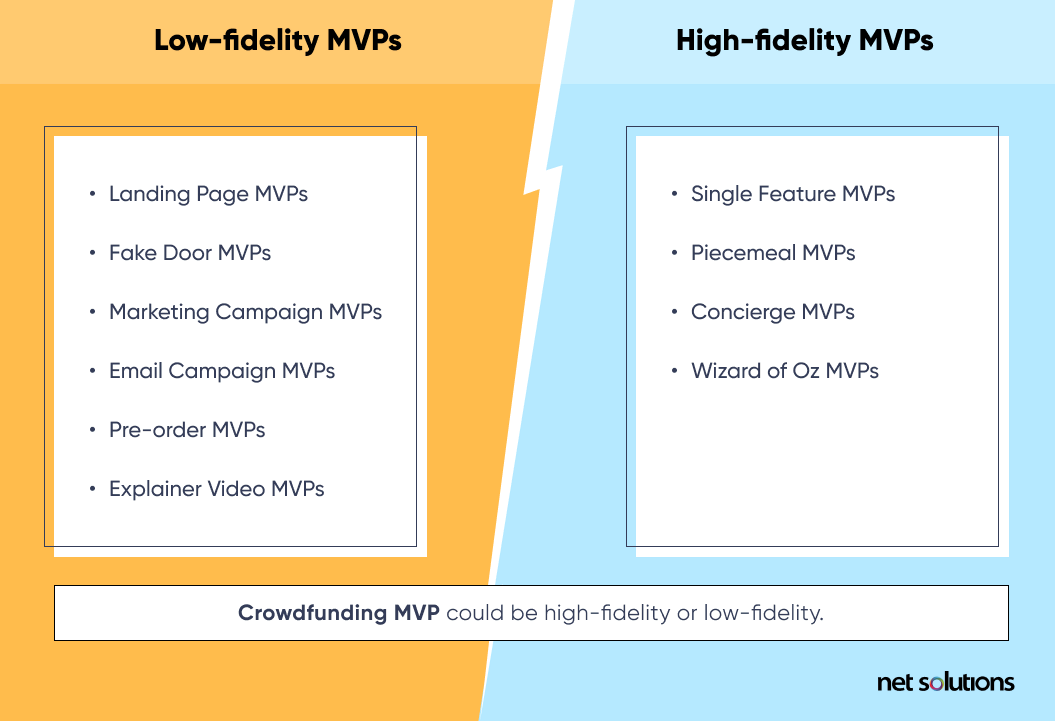
Low-fidelity MVPs, which we’ll cover below, include:
- Landing Page MVPs
- Fake Door MVPs
- Marketing Campaign MVPs
- Email Campaign MVPs
- Pre-order MVPs
- Explainer Video MVPs
High-fidelity MVPs, which we’ll cover as well, include:
- Single Feature MVPs
- Piecemeal MVPs
- Concierge MVPs
- Wizard of Oz MVPs
The wildcard (could be high-fidelity or low-fidelity):
- Crowdfunding MVP
A Crowdfunding MVP might fit into either category because it’s possible to build a functional product before starting a Kickstarter or GoFundMe campaign. However, you could also use those platforms to sell an idea or a prototype, using the funds you receive to support the build. In this case, your crowdfunding MVP would be a low-fidelity one.
There are many examples of MVPs for well-known companies, and you’ll find plenty of examples of both high-fidelity MVPs and low-fidelity MVPs across different industries.
Main Types of Minimum Viable Products to Consider
We’ve broken this list down by low-fidelity MVPs and high-fidelity MVPs, and we’ve added one wildcard at the end that could fall into either category depending on your strategy.
We’ll start our discussion with high-fidelity MVPs since they require the most time and effort to build and launch, then we’ll move on to low-fidelity MVP types.
Keep in mind that many startups use a low-fidelity MVP as the first step toward validating their idea. They then go on to create a high-fidelity MVP once they’re confident there’s a market for it.
Single-feature MVP
The single-feature MVP is what most people think of when they imagine an MVP, so we’ll start there. As the name implies, it delivers on one feature and one feature alone—that key differentiator that will hopefully allow your new product to stand out in the marketplace.
An example of a single-feature MVP was Spotify, which streamed music and nothing more. Prior to Spotify, people bought and downloaded songs from the Apple store for 99 cents, so Spotify needed to determine whether there was a market for streaming.
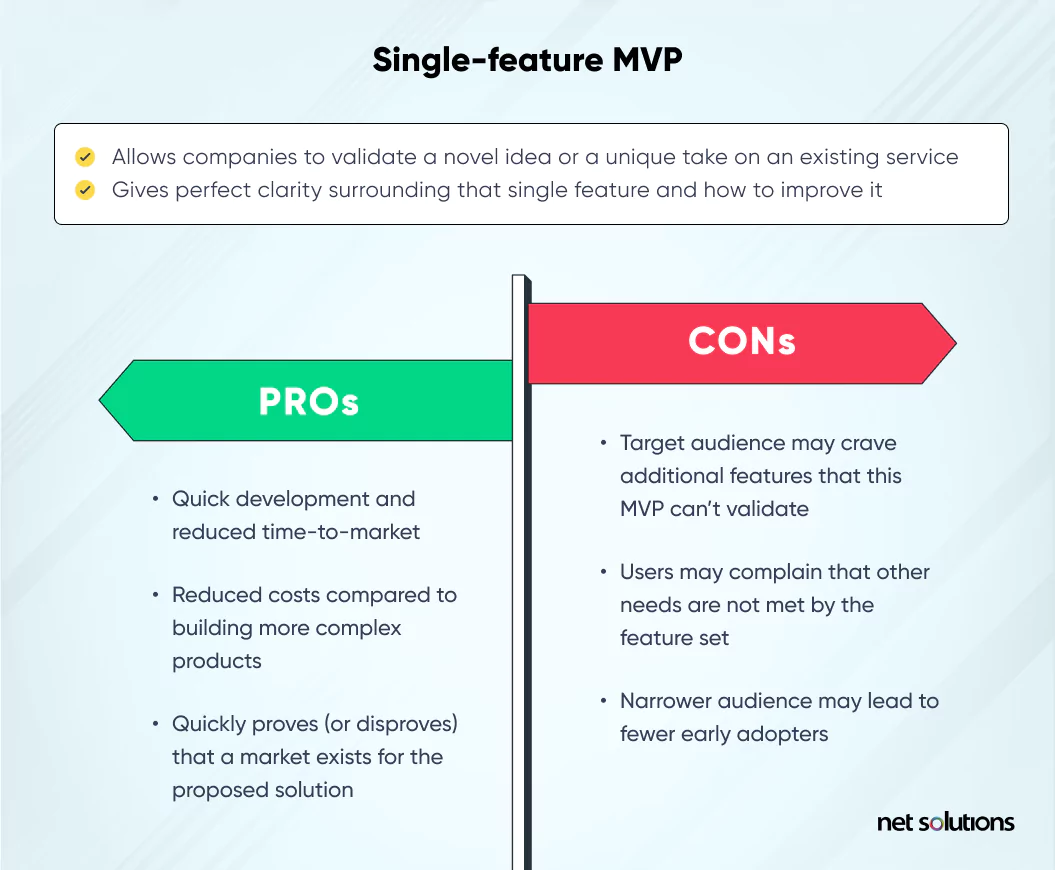
Use cases:
- Allows companies to validate a novel idea or a unique take on an existing service
- Gives perfect clarity surrounding that single feature and how to improve it
| Pros | Cons |
|---|---|
|
|
Piecemeal MVP
MVPs are designed to be as simple as they need to be, but no simpler! In other words, they must include all the necessary tools to deliver the product’s core functionality, and that may involve a number of processes behind the scenes.
A piecemeal MVP uses third-party tools and technologies to bring everything together, rather than having the software development team build each component.
For example, an MVP for a B2B app that allows it to generate coupons and discount codes might require PDF generation, email integration, file management, and search capabilities.
Launching a piecemeal MVP is much easier and far less expensive than building an MVP with all those backend technologies from scratch. It allows the product development team to validate their value proposition and start gathering user feedback relatively quickly.
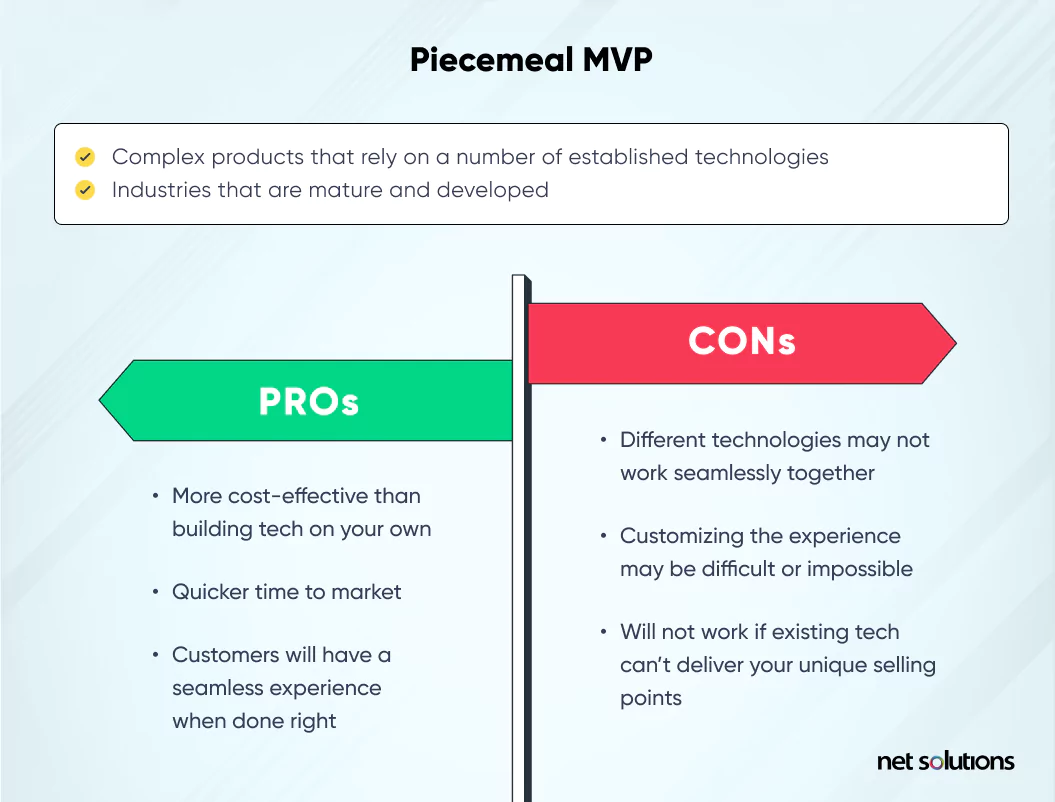
Use cases:
- Complex products that rely on a number of established technologies
- Industries that are mature and developed
| Pros | Cons |
|---|---|
|
|
“Wizard of Oz” MVP
The Wizard of Oz MVP creates the appearance of a fully automated software solution. In reality, however, there’s a human being behind the scenes completing the actions that your fully functional product will someday perform.
Imagine an app that books “onward tickets” so that digital nomads with one-way tickets don’t experience any hassles when entering a new country.
It may appear as though, with the press of a button, the system books a new refundable ticket you can show to the airline before boarding. In reality, however, there’s someone booking the flight and canceling it 48 hours later.
Amazon’s original website is another example of a Wizard of Oz MVP, even though the term didn’t exist back in 1995. People would place orders for books, and someone would place the order manually on the backend.

Use cases:
- Excellent way to validate an idea while keeping MVP costs in check
- Ideal for new features or new products that the market hasn’t seen before
| Pros | Cons |
|---|---|
|
|
Concierge MVP
A Concierge MVP is a website or platform that connects customers with people who want to perform a given task. Instead of creating an automated solution, the Concierge MVP receives a command from potential customers, and a human being fulfills it.
Does that sound a lot like the Wizard of Oz MVP we just talked about? Of course it does, because it’s nearly the same thing with one key differentiator. The Wizard of Oz MVP creates the illusion of automation, just like the wizard did in Dorothy’s adventure.
By contrast, the concierge MVP is fully up-front about what it’s doing—there’s no “man behind the curtain” because there’s no curtain.
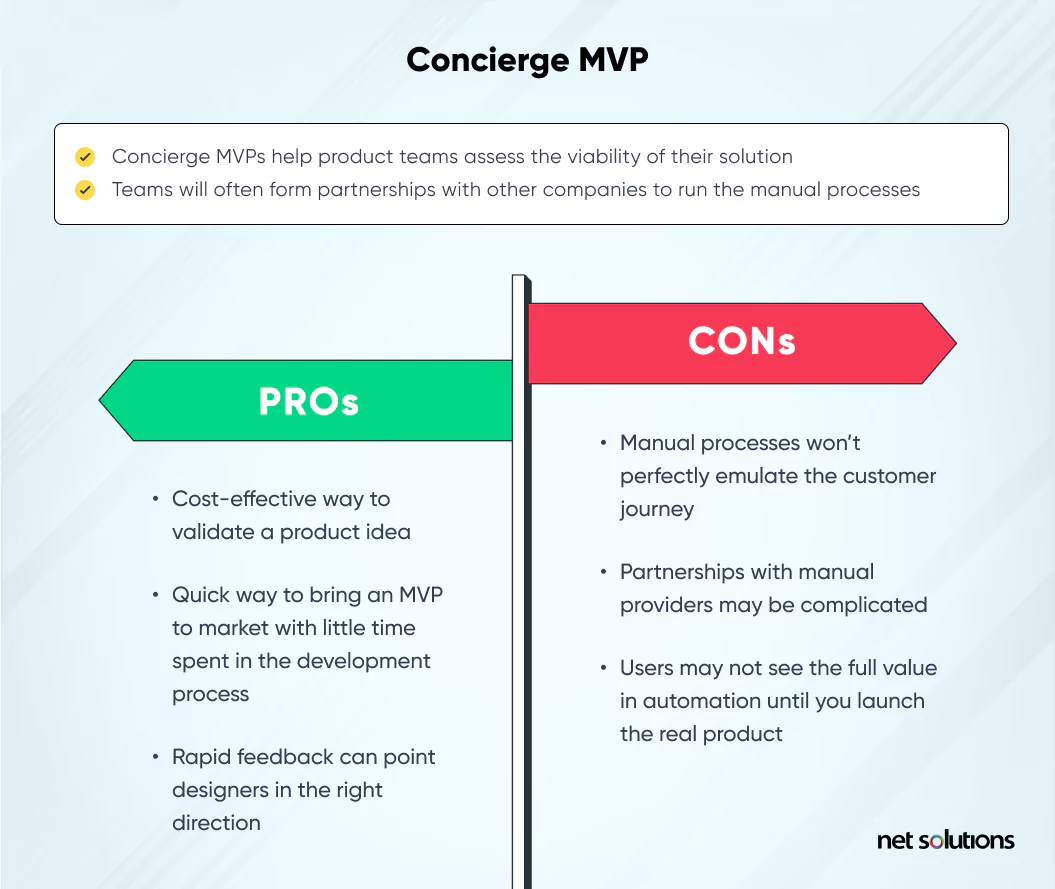
Use cases:
- Concierge MVPs help product teams assess the viability of their solution
- Teams will often form partnerships with other companies to run the manual processes
| Pros | Cons |
|---|---|
|
|
Crowdfunding MVP
The Crowdfunding MVP could be categorized as low-fidelity or high-fidelity, depending on whether you’ve got a working model of the product that people can download and explore during your campaign.
Crowdfunding is an excellent way to build buzz around an interesting, novel product idea. If people are willing to back your idea and you reach your funding goal, you’ve definitely validated demand for it. It’s also a great way to build an initial user base. And of course, the funding can help startups get off the ground with minimal investment.
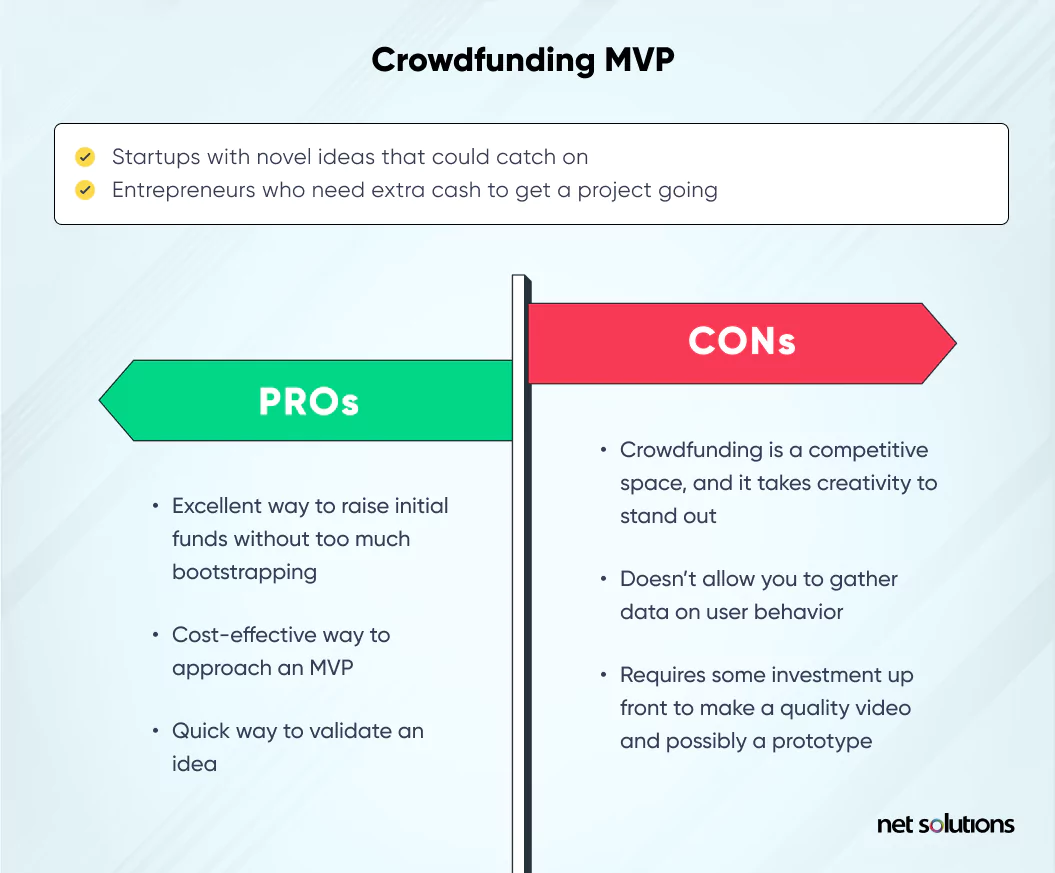
Use cases:
- Startups with novel ideas that could catch on
- Entrepreneurs who need extra cash to get a project going
| Pros | Cons |
|---|---|
|
|
Landing page MVP
A landing page MVP is a low-fidelity MVP, as are all the MVP types that follow. As the most basic type of MVP available, it simply consists of a landing page that touts your upcoming product idea without requiring you to spend weeks or months in MVP development.
Rather than creating a functional product, the landing page MVP is used to garner interest and build an email list of potential users who may want to test your high-fidelity MVP when it’s available. It’s essentially the first step toward validating the product idea, and it’s a solid marketing strategy.
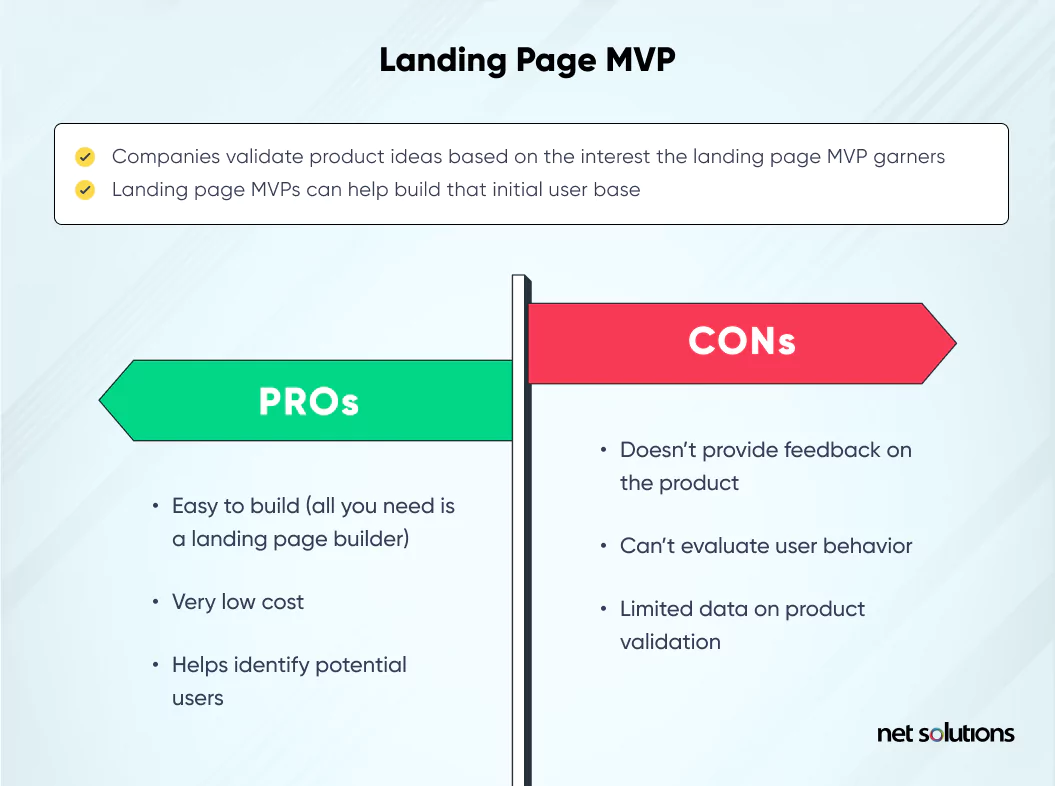
Use cases:
- Companies validate product ideas based on the interest the landing page MVP garners
- Landing page MVPs can help build that initial user base
| Pros | Cons |
|---|---|
|
|
“Fake door” MVP
The Fake Door MVP is similar to the landing page MVP, but it goes a step further by advertising a product or feature as though it actually exists. This provides solid data on whether someone would be willing to purchase the product, rather than evaluating hypothetical interest.
What happens when someone clicks to purchase it? That’s when you reveal that the product or feature set is still under development. That runs the risk of annoying customers, so use this approach sparingly.
Test just enough potential users to validate your idea. Once you do so, get to work building a product or feature set they’re willing to pay for.
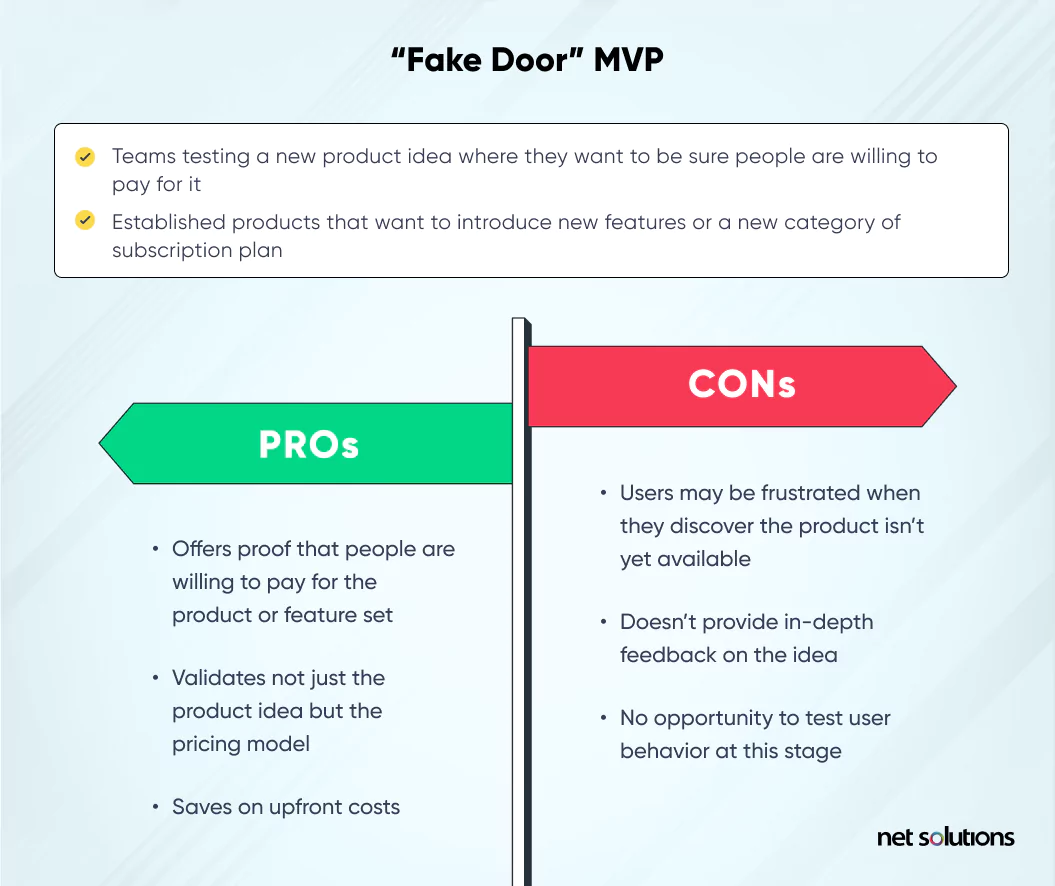
Use cases:
- Teams testing a new product idea where they want to be sure people are willing to pay for it
- Established products that want to introduce new features or a new category of subscription plan
| Pros | Cons |
|---|---|
|
|
Marketing campaign MVP
A marketing campaign MVP makes full use of all the different marketing channels available to product development teams today, including:
- PPC advertising
- Social media marketing
- Forums (such as Reddit)
- New product platforms (such as Product Hunt)
- Any other popular advertising method
By garnering interest and getting potential users to sign up for your mailing list and receive updates, you’ll both build your user base and validate your product.
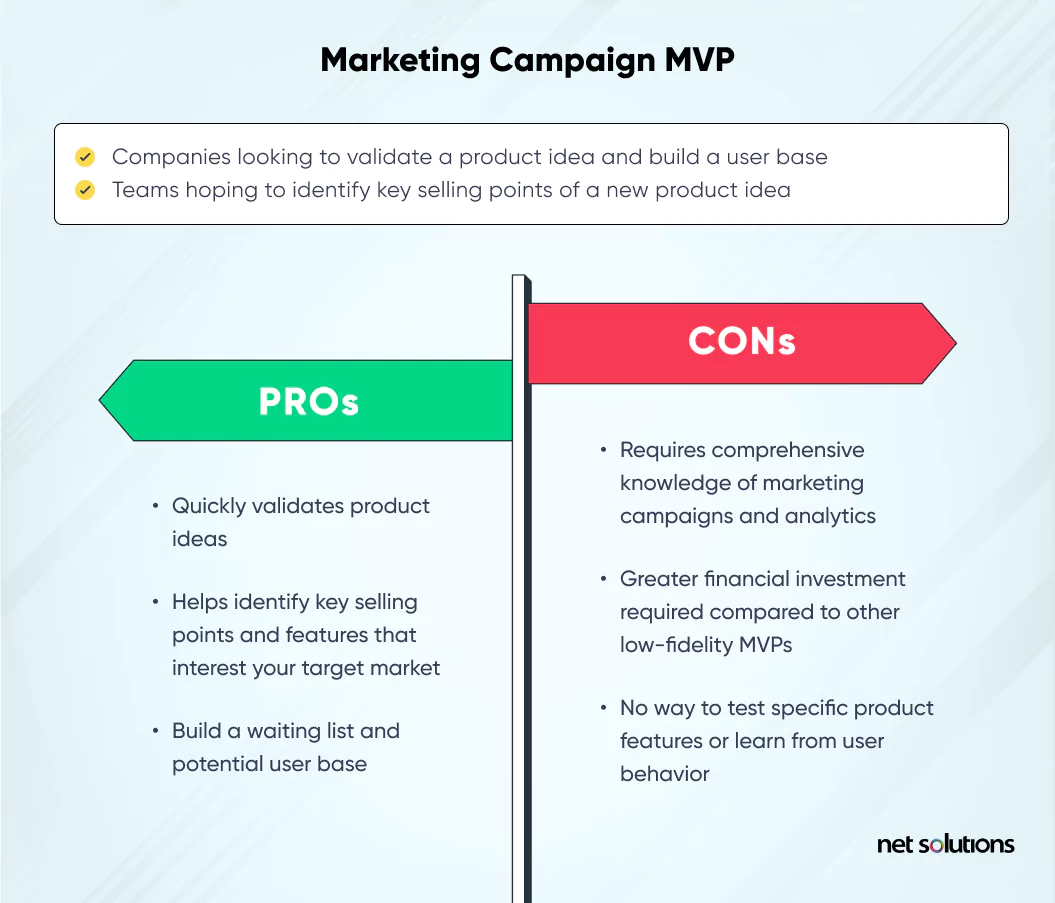
Use cases:
- Companies looking to validate a product idea and build a user base
- Teams hoping to identify key selling points of a new product idea
| Pros | Cons |
|---|---|
|
|
Email campaign MVP
An email campaign MVP, or email MVP, is similar to the marketing campaign MVP, except that it focuses exclusively on marketing your MVP through email. This can work great if you’ve got a solid email list or you can partner with someone who does.
Just avoid purchasing lists or spamming people who didn’t opt into your list because that can get you in all kinds of hot water. It can put your domain onto spam lists, and it can destroy your brand.
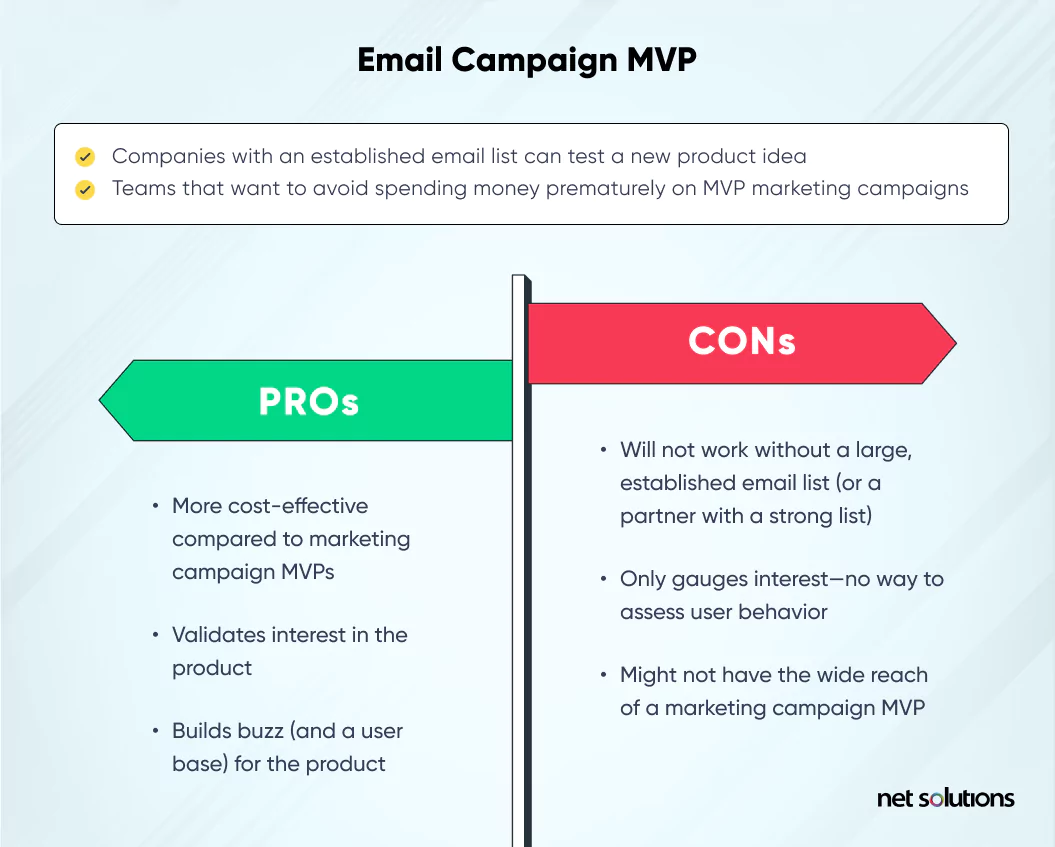
Use cases:
- Companies with an established email list can test a new product idea
- Teams that want to avoid spending money prematurely on MVP marketing campaigns
| Pros | Cons |
|---|---|
|
|
Pre-order MVP
A pre-order MVP offers customers the opportunity to pay upfront for a product you promise to deliver at a later date. This can work well for established companies that have already delivered products that users love, but it will be a hard sell for a startup with nothing to support its credibility.
The pre-order MVP is the ultimate form of validation for a low-fidelity MVP because people vote with their money. It also allows you to make money upfront, which you can allocate toward building a better product.
That said, it does lock you into those promises. If you don’t deliver the features you said you would deliver, or you miss your delivery dates, people may be upset. In fact, you could be legally liable if you fail to meet those deadlines since people have already paid for the product.
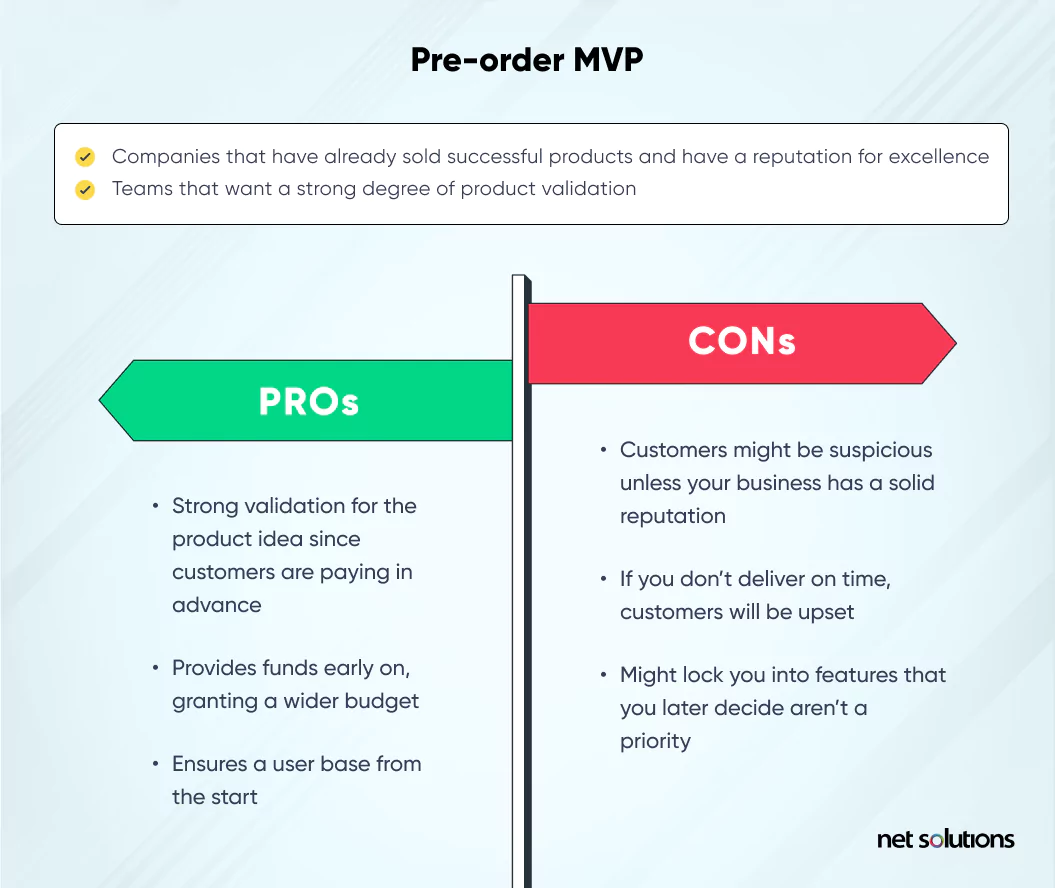
Use cases:
- Companies that have already sold successful products and have a reputation for excellence
- Teams that want a strong degree of product validation
| Pros | Cons |
|---|---|
|
|
Explainer video MVP
An explainer video MVP uses, as the name implies, a short video to explain a hypothetical product—just like those that companies use to explain existing products. The difference is that an explainer video MVP’s call-to-action is usually to sign up for the mailing list and get updates when the product is available.
Explainer videos are effective at helping people understand how unique products work. Dropbox’s MVP was an explainer video, which was helpful at the time because off-site storage was something enterprises used (not regular people or small businesses).

Use cases:
- Companies seeking to explain a product that many people aren’t familiar with
- Organizations looking to validate a complex idea
| Pros | Cons |
|---|---|
|
|
How to Choose the Right Type of MVP for Your Product
Choosing the right MVP for your software product will depend on a variety of factors. It’s important to assess your unique needs and challenges before settling on an MVP approach.
Teams working on projects with limited budgets might want to consider low-fidelity MVPs, since they require the least investment of time and labor. Companies with larger budgets who want solid data regarding user feedback and behavior may want to choose one of the high-fidelity approaches.
You should also consider who you’re trying to reach and how easy it is to reach them. Other factors include how likely your idea is to attract attention on its own, how much expertise you have in-house to make a specific approach work, and what resources you have available (e.g., email lists, advertising budget) to get the word out.
There are countless benefits of the MVP approach, and choosing the right type of MVP for your product will help you harness them.
Need Help Developing an MVP?
Net Solutions is a software development firm that has designed thousands of software products over the past 24 years, including countless MVPs for startups and enterprises alike. We’ve worked with the Harvard Business Review, IMG, Xerox, and many others.
We’re not just developers, either! We’re a full-service firm that can help you with every aspect of your strategy and MVP launch: User research, prototyping, design, development, testing, launch, and future iterations.
We can take care of the entire project, or we can offer support with any individual aspect of your MVP project. Contact us today to discuss your idea.
SHARE THIS POST
Table of Contents
Related Resources
- What Is an MVP App? A Guide to Building Successful Products
- A Deep Dive Into 7 Minimum Viable Product Benefits
- A Step-by-Step Guide to Build a Minimum Viable Product (MVP)
- 19-Step Minimum Viable Product (MVP) Checklist [With PDF]
- How Much Does a Minimum Viable Product (MVP) Cost? Here’s the Answer
- 10 Top MVP Development Companies [Great for Startups]
- 10 Minimum Viable Product (MVP) Examples You Should Know
- The Ultimate Guide to Developing an MVP in Agile: What, How, and Why
- A Step-by-Step Guide on how to Master Your MVP Launch in 2024
- How to Prioritize Features for Your Minimum Viable Product (MVP)
- How to Test an MVP: 15 Proven Strategies that Work
- 20 Great MVP Tools to Help You Create & Launch Your Product
- How to Nail MVP Design with UX Design Principles that Work
- MVP Website: Benefits, Best Practices, How to Build & More

